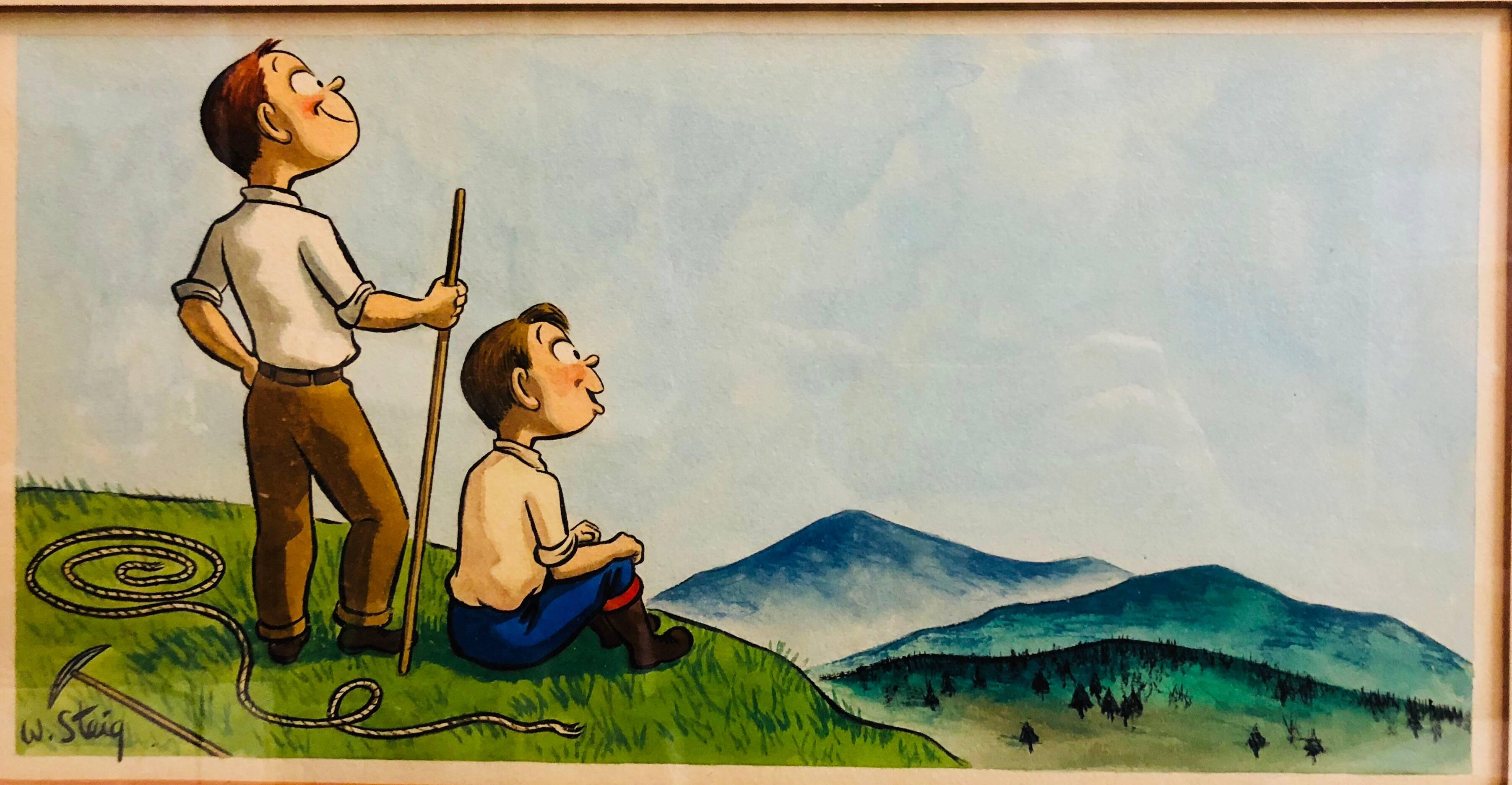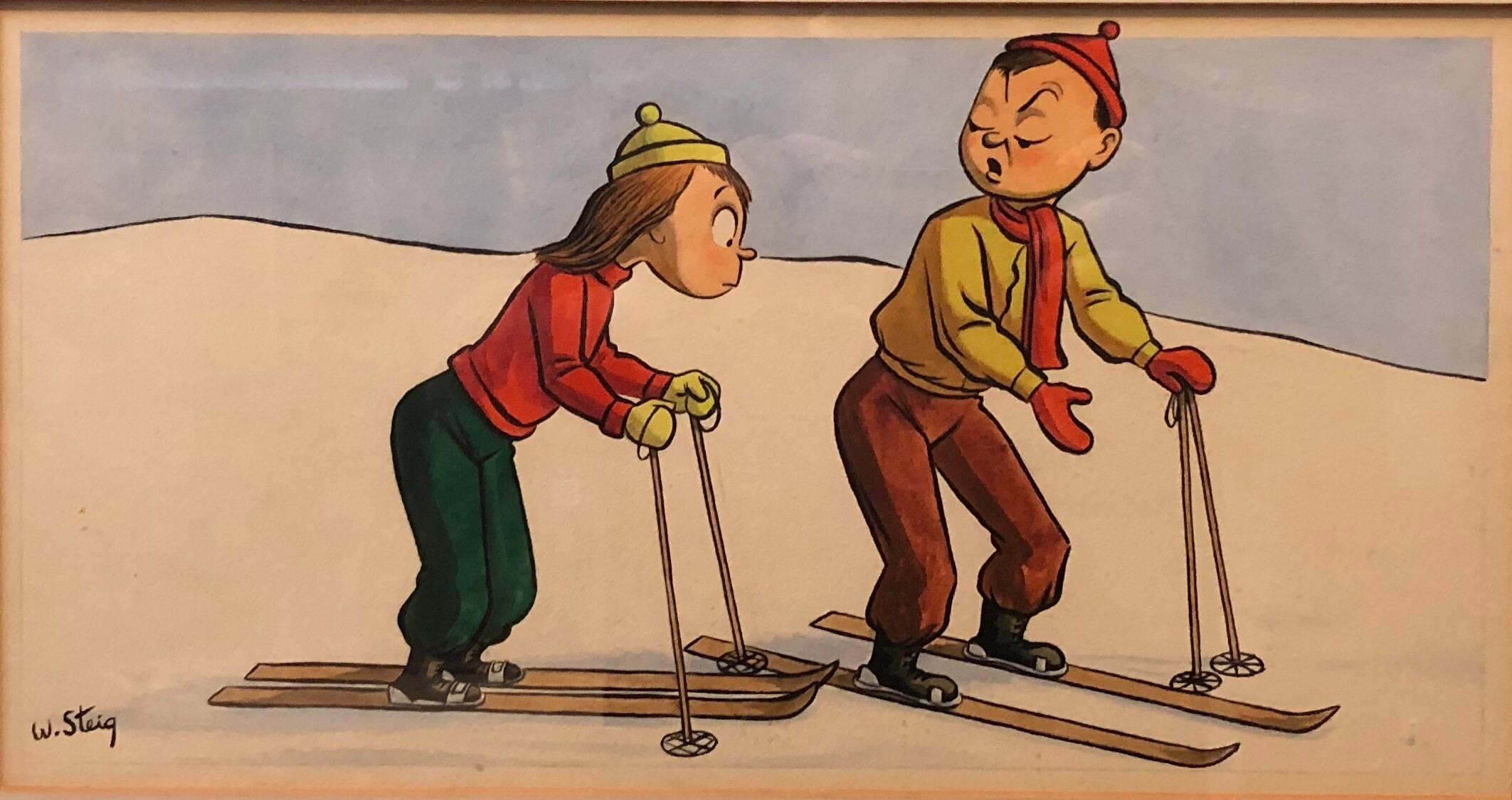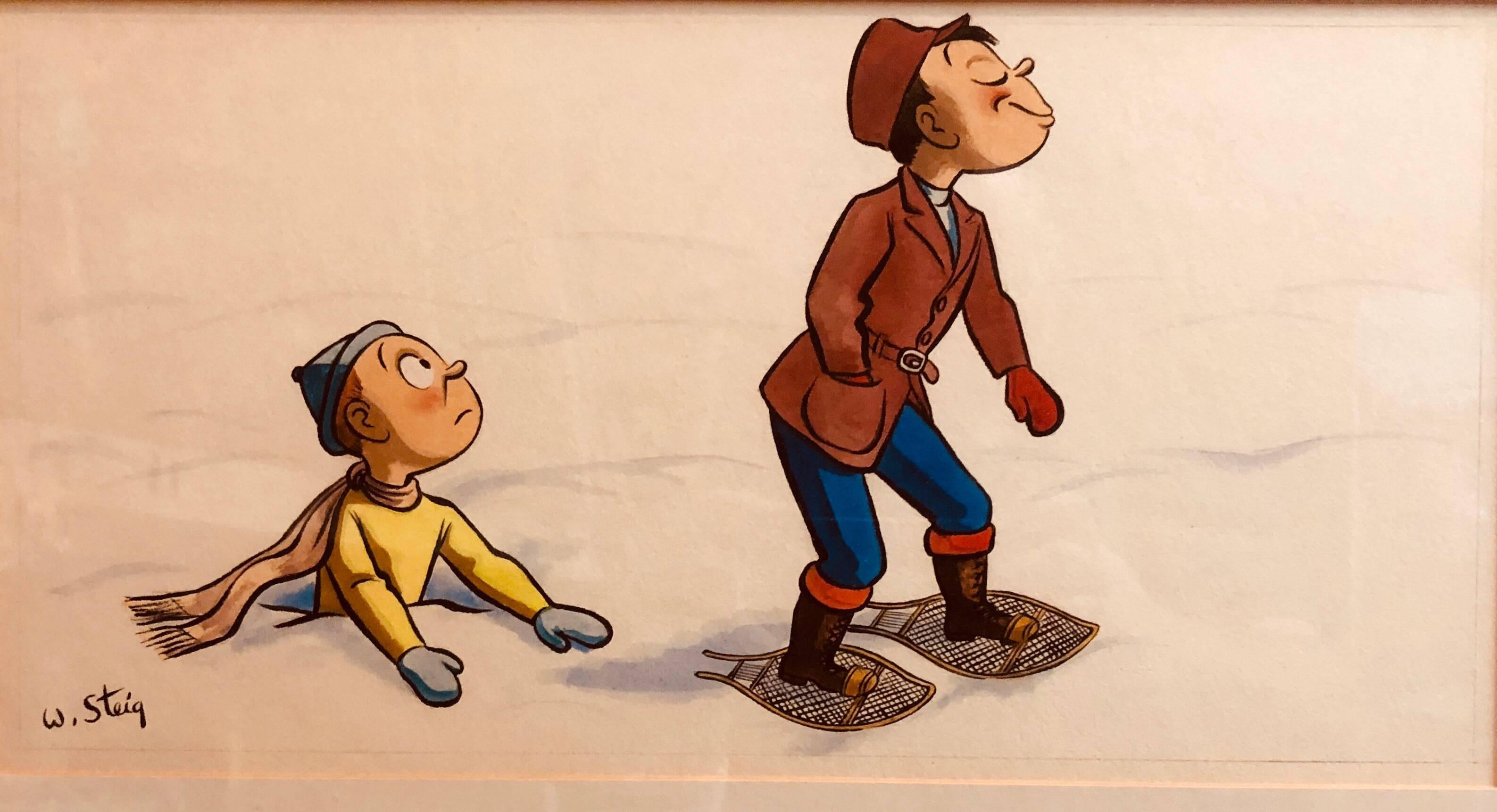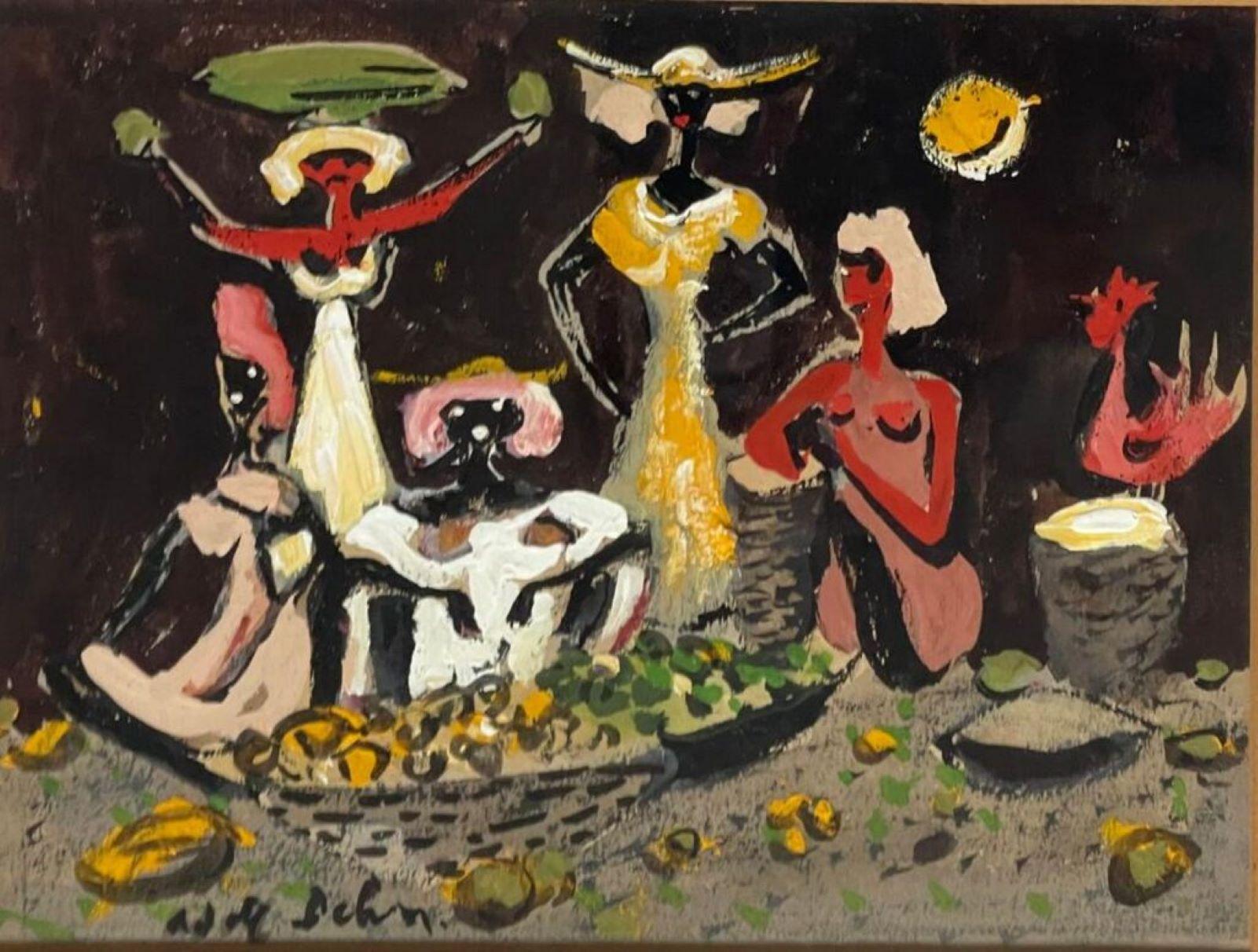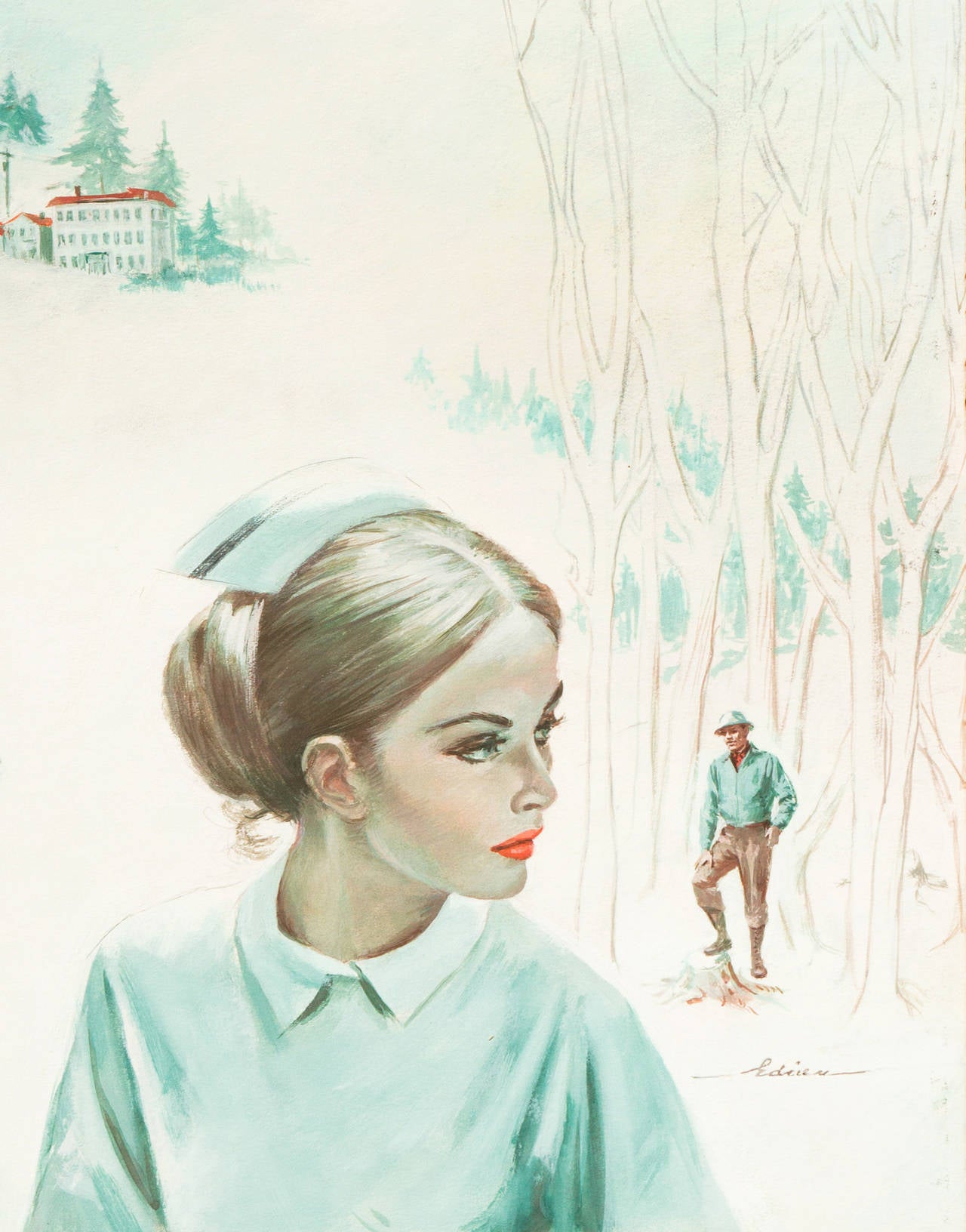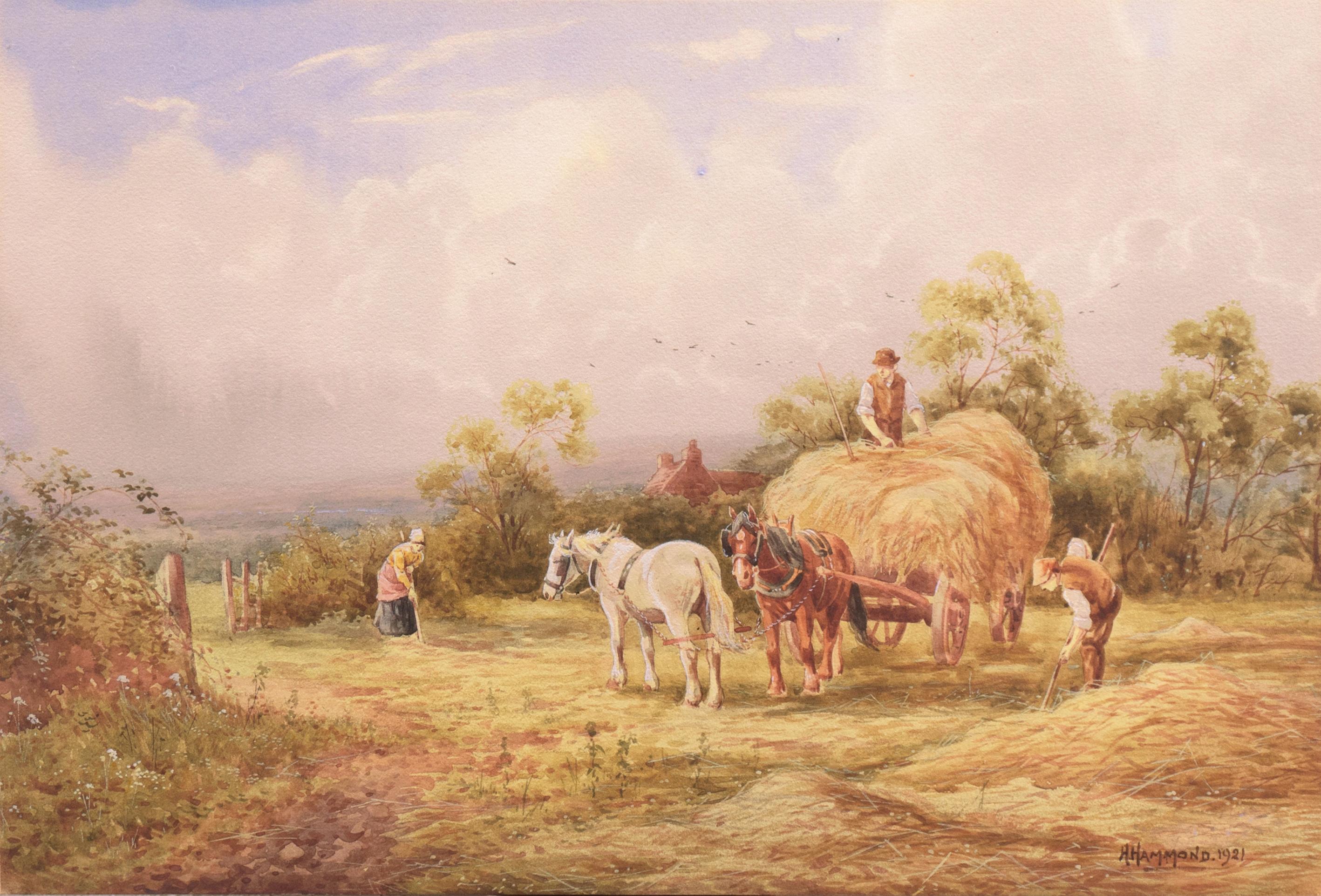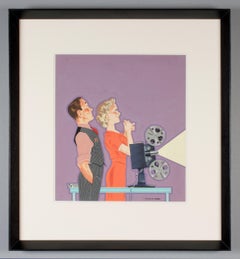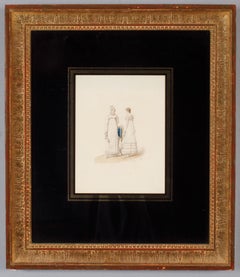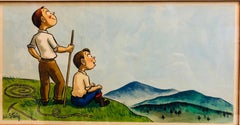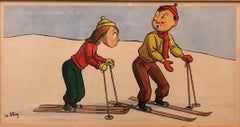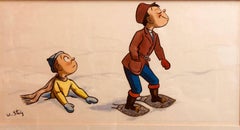Items Similar to Humorous Illustration of a Stock Trader by Maurice Freed
Want more images or videos?
Request additional images or videos from the seller
1 of 4
Maurice FreedHumorous Illustration of a Stock Trader by Maurice Freedc. 1940
c. 1940
About the Item
Maurice Freed
(American, 1911-1981)
Trader, c. 1940
Watercolor on board, 10 1/4 x 8 1/4 inches
FRAMED: 17 x 14 inches (approx.)
Signed at lower right: “MAURICE FREED”
Maurice Freed, a native of Pottsville, Pa. and a graduate of the Pennsylvania Museum and School of Industrial Art (now the University of the Arts), lived and painted in Philadelphia during most of his life. At the age of 19, he won a scholarship to the Cape School of Art in Provincetown where he studied with Henry Hensche, Morris Davidson, and Albert Alcalay. In 1934, at the age of 23, his talents were recognized when he was invited to Chicago to become Co-Art Director of Esquire magazine.
As an illustrator, Maurice Freed’s work was published in Esquire, The New Yorker, Holiday Magazine, as well as a cover for Fortune Magazine. He also did commercial illustrations for companies from TastyKake to Penn Wax Works, designed covers for a variety of published books, brochures for music programs in Philadelphia including the Settlement Music School, as well as for Art Festivals in Philadelphia.
- Creator:Maurice Freed (1911 - 1981, American)
- Creation Year:c. 1940
- Dimensions:Height: 10.25 in (26.04 cm)Width: 8.25 in (20.96 cm)
- Medium:
- Period:
- Condition:
- Gallery Location:Philadelphia, PA
- Reference Number:Seller: RS 67621stDibs: LU2390215492252
About the Seller
5.0
Recognized Seller
These prestigious sellers are industry leaders and represent the highest echelon for item quality and design.
1stDibs seller since 2023
10 sales on 1stDibs
- ShippingRetrieving quote...Shipping from: Philadelphia, PA
- Return Policy
Authenticity Guarantee
In the unlikely event there’s an issue with an item’s authenticity, contact us within 1 year for a full refund. DetailsMoney-Back Guarantee
If your item is not as described, is damaged in transit, or does not arrive, contact us within 7 days for a full refund. Details24-Hour Cancellation
You have a 24-hour grace period in which to reconsider your purchase, with no questions asked.Vetted Professional Sellers
Our world-class sellers must adhere to strict standards for service and quality, maintaining the integrity of our listings.Price-Match Guarantee
If you find that a seller listed the same item for a lower price elsewhere, we’ll match it.Trusted Global Delivery
Our best-in-class carrier network provides specialized shipping options worldwide, including custom delivery.More From This Seller
View AllWhimsical Illustration of a Couple With a Home Movie Projector by Maurice Freed
By Maurice Freed
Located in Philadelphia, PA
Maurice Freed
(American, 1911 1981)
Home Movies (I), c. 1940
Gouache on board, 13 1/2 x 12 inches
FRAMED: 20 x 19 inches (approx.)
Signed at lower right: “MAURICE FREED”
Maurice F...
Category
Mid-20th Century Other Art Style Figurative Drawings and Watercolors
Materials
Gouache, Board
Humorous Illustration of a Man Walking his Dog by Maurice Freed
By Maurice Freed
Located in Philadelphia, PA
Maurice Freed
(American, 1911-1981)
Dog Walking
Watercolor on board, 8 x 12 1/2 inches
FRAMED: 14 1/2 x 18 1/2 inches (approx.)
Signed at lower left: “MAURICE FREED”
Maurice Freed...
Category
Mid-20th Century Other Art Style Animal Drawings and Watercolors
Materials
Watercolor, Board
Peasants in a Landscape: Antique Watercolor on Vellum
Located in Philadelphia, PA
Unknown Artist
(probably French, probably late 18th-early 19th century)
Peasants in a Landscape
Ink, watercolor, and gouache on vellum, 12 5/8 x 19 3/8 inches
FRAMED: 21 x 27 inches...
Category
Late 18th Century French School Landscape Drawings and Watercolors
Materials
Ink, Watercolor, Gouache, Vellum
French Fashion: Two Ladies, a drawing by Horace Vernet, 1814
By Émile Jean-Horace Vernet
Located in Philadelphia, PA
Horace Vernet
(French, 1789-1863)
Two Ladies Standing, 1814
Watercolor on paper, 8 x 6 1/4 inches
Framed: 15 x 13 inches (approx.)
Signed and dated at lower right: "H.Vernet--1814."...
Category
1810s Realist Interior Drawings and Watercolors
Materials
Paper, Watercolor, Pencil
Watercolor Portrait of a Girl with Roses signed Bowman 1906
Located in Philadelphia, PA
Unknown Artist (Bowman)
(early twentieth century)
Girl with Roses
Watercolor on paper, 5 x 8 inches
Framed: 13 x 16 inches
Signed and dated at lower right: “Bowman/.06”
Category
Early 1900s Realist Landscape Drawings and Watercolors
Materials
Paper, Watercolor
Standing Female Nude watercolor by Philadelphia Artist Adolphe Borie
Located in Philadelphia, PA
ADOLPHE BORIE
(American, 1877-1934)
Standing Female Nude
Wash & charcoal on gray laid paper, 12 x 9 inches
Framed: 16 x 13 inches
Estate stamp lower right
Born in Philadelphia, Adol...
Category
Early 20th Century Modern Figurative Drawings and Watercolors
Materials
Paper, Watercolor, Charcoal
You May Also Like
Whimsical Illustration Hiking Cartoon, 1938 Mt Tremblant Ski Lodge William Steig
By William Steig (b.1907)
Located in Surfside, FL
Lighthearted Illustration of Outdoor Pursuits This one being cross country hiking signed "W. Steig"
Provenance: from Mrs. Joseph B. Ryan, Commissioned by Joe Ryan for the bar at his ski resort, Mount Tremblant Lodge, in 1938.
Mont Tremblant, P.Q., Canada
Watercolor and ink on illustration board, sights sizes 8 1/2 x 16 1/2 in., framed.
In 1938 Joe Ryan, described as a millionaire from Philadelphia, bushwhacked his way to the summit of Mont Tremblant and was inspired to create a world class ski resort at the site. In 1939 he opened the Mont Tremblant Lodge, which remains part of the Pedestrian Village today. This original illustration is on Whatman Illustration board. the board measures 14 X 22 inches. label from McClees Galleries, Philadelphia, on the frame backing paper.
William Steig, 1907 – 2003 was an American cartoonist, sculptor, and, in his later life, an illustrator and writer of children's books. Best known for the picture books Sylvester and the Magic Pebble, Abel's Island, and Doctor De Soto, he was also the creator of Shrek!, which inspired the film series of the same name. He was the U.S. nominee for both of the biennial, international Hans Christian Andersen Awards, as a children's book illustrator in 1982 and a writer in 1988.
Steig was born in Brooklyn, New York in 1907, and grew up in the Bronx. His parents were Polish-Jewish immigrants from Austria, both socialists. His father, Joseph Steig, was a house painter, and his mother, Laura Ebel Steig, was a seamstress who encouraged his artistic leanings. As a child, he dabbled in painting and was an avid reader of literature. Among other works, he was said to have been especially fascinated by Pinocchio.He graduated from Townsend Harris High School at 15 but never completed college, though he attended three, spending two years at City College of New York, three years at the National Academy of Design and a mere five days at the Yale School of Fine Arts before dropping out of each.
Hailed as the "King of Cartoons" Steig began drawing illustrations and cartoons for The New Yorker in 1930, producing more than 2,600 drawings and 117 covers for the magazine. Steig, later, when he was 61, began writing children's books. In 1968, he wrote his first children's book. He excelled here as well, and his third book, Sylvester and the Magic Pebble (1969), won the Caldecott Medal. He went on to write more than 30 children's books, including the Doctor DeSoto series, and he continued to write into his nineties. Among his other well-known works, the picture book Shrek! (1990) formed the basis for the DreamWorks Animation film Shrek (2001). After the release of Shrek 2 in 2004, Steig became the first sole-creator of an animated movie franchise that went on to generate over $1 billion from theatrical and ancillary markets after only one sequel. Along with Maurice Sendak, Saul Steinberg, Ludwig Bemelmans and Laurent de Brunhofff his is one of those rare cartoonist whose works form part of our collective cultural heritage.
In 1984, Steig's film adaptation of Doctor DeSoto directed by Michael Sporn was nominated for the Academy Award for Best Animated Short Film. As one of the most admired cartoonists of all time, Steig spent seven decades drawing for the New Yorker magazine. He touched generations of readers with his tongue–in–cheek pen–and–ink drawings, which often expressed states of mind like shame, embarrassment or anger. Later in life, Steig turned to children's books, working as both a writer and illustrator.
Steig's children's books were also wildly popular because of the crazy, complicated language he used—words like lunatic, palsied, sequestration, and cleave. Kids love the sound of those words even if they do not quite understand the meaning. Steig's descriptions were also clever. He once described a beached whale as "breaded with sand."
Throughout the course of his career, Steig compiled his cartoons and drawings into books. Some of them were published first in the New Yorker. Others were deemed too dark to be printed there. Most of these collections centered on the cold, dark psychoanalytical truth about relationships. They featured husbands and wives fighting and parents snapping at their kids. His first adult book, Man About Town, was published in 1932, followed by About People, published in 1939, which focused on social outsiders. Sick of Each Other, published in 2000, included a drawing depicting a wife holding her husband at gunpoint, saying, "Say you adore me."
According to the Los Angeles Times, fellow New Yorker artist Edward Sorel...
Category
1930s Naturalistic Figurative Drawings and Watercolors
Materials
Archival Ink, Watercolor, Illustration Board
Whimsical Illustration Skiing Cartoon, 1938 Mt Tremblant Ski Lodge William Steig
By William Steig (b.1907)
Located in Surfside, FL
Lighthearted Illustration of Outdoor Pursuits This one being a Skiing scene, a boy and a girl on skis. signed W. Steig
Provenance: from Mrs. Joseph B. Ryan, Commissioned by Joe Ryan for the bar at his ski resort, Mount Tremblant Lodge, in 1938.
Mont Tremblant, P.Q., Canada
Watercolor and ink on illustration board, sights sizes 8 1/2 x 16 1/2 in., framed.
In 1938 Joe Ryan, described as a millionaire from Philadelphia, bushwhacked his way to the summit of Mont Tremblant and was inspired to create a world class ski resort at the site. In 1939 he opened the Mont Tremblant Lodge, which remains part of the Pedestrian Village today. This original illustration is on Whatman Illustration board. the board measures 14 X 22 inches. label from McClees Galleries, Philadelphia, on the frame backing paper.
William Steig, 1907 – 2003 was an American cartoonist, sculptor, and, in his later life, an illustrator and writer of children's books. Best known for the picture books Sylvester and the Magic Pebble, Abel's Island, and Doctor De Soto, he was also the creator of Shrek!, which inspired the film series of the same name. He was the U.S. nominee for both of the biennial, international Hans Christian Andersen Awards, as a children's book illustrator in 1982 and a writer in 1988.
Steig was born in Brooklyn, New York in 1907, and grew up in the Bronx. His parents were Polish-Jewish immigrants from Austria, both socialists. His father, Joseph Steig, was a house painter, and his mother, Laura Ebel Steig, was a seamstress who encouraged his artistic leanings. As a child, he dabbled in painting and was an avid reader of literature. Among other works, he was said to have been especially fascinated by Pinocchio.He graduated from Townsend Harris High School at 15 but never completed college, though he attended three, spending two years at City College of New York, three years at the National Academy of Design and a mere five days at the Yale School of Fine Arts before dropping out of each.
Hailed as the "King of Cartoons" Steig began drawing illustrations and cartoons for The New Yorker in 1930, producing more than 2,600 drawings and 117 covers for the magazine. Steig, later, when he was 61, began writing children's books. In 1968, he wrote his first children's book. He excelled here as well, and his third book, Sylvester and the Magic Pebble (1969), won the Caldecott Medal. He went on to write more than 30 children's books, including the Doctor DeSoto series, and he continued to write into his nineties. Among his other well-known works, the picture book Shrek! (1990) formed the basis for the DreamWorks Animation film Shrek (2001). After the release of Shrek 2 in 2004, Steig became the first sole-creator of an animated movie franchise that went on to generate over $1 billion from theatrical and ancillary markets after only one sequel. Along with Maurice Sendak, Saul Steinberg, Ludwig Bemelmans and Laurent de Brunhofff his is one of those rare cartoonist whose works form part of our collective cultural heritage.
In 1984, Steig's film adaptation of Doctor DeSoto directed by Michael Sporn was nominated for the Academy Award for Best Animated Short Film. As one of the most admired cartoonists of all time, Steig spent seven decades drawing for the New Yorker magazine. He touched generations of readers with his tongue–in–cheek pen–and–ink drawings, which often expressed states of mind like shame, embarrassment or anger. Later in life, Steig turned to children's books, working as both a writer and illustrator.
Steig's children's books were also wildly popular because of the crazy, complicated language he used—words like lunatic, palsied, sequestration, and cleave. Kids love the sound of those words even if they do not quite understand the meaning. Steig's descriptions were also clever. He once described a beached whale as "breaded with sand."
Throughout the course of his career, Steig compiled his cartoons and drawings into books. Some of them were published first in the New Yorker. Others were deemed too dark to be printed there. Most of these collections centered on the cold, dark psychoanalytical truth about relationships. They featured husbands and wives fighting and parents snapping at their kids. His first adult book, Man About Town, was published in 1932, followed by About People, published in 1939, which focused on social outsiders. Sick of Each Other, published in 2000, included a drawing depicting a wife holding her husband at gunpoint, saying, "Say you adore me."
According to the Los Angeles Times, fellow New Yorker artist Edward Sorel...
Category
1930s Naturalistic Figurative Drawings and Watercolors
Materials
Archival Ink, Watercolor, Illustration Board
Whimsical Illustration "Snow" Cartoon, 1938 Mt Tremblant Ski Lodge William Steig
By William Steig (b.1907)
Located in Surfside, FL
Lighthearted Illustration of Outdoor Pursuits This one being cross country Snow Shoes signed "W. Steig"
Provenance: from Mrs. Joseph B. Ryan, Commissioned by ...
Category
1930s American Modern Figurative Drawings and Watercolors
Materials
India Ink, Watercolor, Illustration Board
Adolf Dehn, Haitian Scene A, signed painting, Associated American Artists, 1950s
By Adolf Arthur Dehn
Located in New York, NY
Adolf Arthur Dehn
Haitian Scene A, ca. 1951
Watercolor gouache on board
Signed on the front
Frame included: held in vintage modern frame
Measurements:
Framed:
11 inches vertical by 13 inches horizontal by .75
Painting
4.5 inches by 6 inches
Watercolor gouache, hand signed; framed with AAA Gallery label verso
Signed on the front bearing the original label on the verso of Dehn's longtime gallery, the prestigious Associated American Artists Gallery, New York City.
Provenance
Associated American Artists
Frame included: held in vintage frame with original label as provenance
Dehn, an influential artist and teacher (and author of the definitive textbook of his era on watercolor painting) joined Associated American Artists gallery in 1941. Although this painting is undated, it is likely circa early 1950s, as in 1951 Dehn won a Guggenheim Fellowship, which enabled him to travel to Haiti -- the subject of this work. It was part of a series inspired by Dehn's visit to Haiti.
Dehn, an influential artist and teacher (and author of the definitive textbook of his era on watercolor painting) joined Associated American Artists gallery in 1941. Although this painting is undated, it is likely circa early 1950s, as in 1951 Dehn won a Guggenheim Fellowship, which enabled him to travel to Haiti.
ADLOF DEHN
Adolf Dehn, American Watercolorist and Printmaker, 1895-1968
Adolf Dehn was an artist who achieved extraordinary artistic heights, but in a very particular artistic sphere - not so much in oil painting as in watercolor and lithography. Long recognized as a master by serious print collectors, he is gradually gaining recognition as a notable and influential figure in the overall history of American art.
In the 19th century, with the invention of the rotary press, which made possible enormous print runs, and the development of the popular, mass-market magazines, newspaper and magazine illustration developed into an artistic realm of its own, often surprisingly divorced from the world of museums and art exhibitions, and today remains surprisingly overlooked by most art historians. Dehn in many regards was an outgrowth of this world, although in an unusual way, since as a young man he produced most of his illustrative work not for popular magazines, such as The Saturday Evening Post, but rather for radical journals, such as The Masses or The Liberator, or artistic "little magazines" such as The Dial. This background established the foundation of his outlook, and led later to his unique and distinctive contribution to American graphic art.
If there’s a distinctive quality to his work, it was his skill in introducing unusual tonal and textural effects into his work, particularly in printmaking but also in watercolor. Jackson Pollock seems to have been one of many notable artists who were influenced by his techniques.
Early Years, 1895 - 1922
For an artist largely remembered for scenes of Vienna and Paris, Adolf Dehn’s background was a surprising one. Born in Waterville, Minnesota, on November 22, 1895, Dehn was the descendent of farmers who had emigrated from Germany and homesteaded in the region, initially in a one-room log cabin with a dirt floor. Adolf’s father, Arthur Clark Dehn, was a hunter and trapper who took pride that he had no boss but himself, and who had little use for art. Indeed, during Adolf’s boyhood the walls of his bedroom and the space under his bed were filled with the pelts of mink, muskrats and skunks that his father had killed, skinned and stretched on drying boards. It was Adolf’s mother, Emilie Haas Dehn, a faithful member of the German Lutheran Evangelical Church, who encouraged his interest in art, which became apparent early in childhood. Both parents were ardent socialists, and supporters of Eugene Debs...
Category
1950s Modern Figurative Drawings and Watercolors
Materials
Watercolor, Gouache, Board
'Timberline Nurse', American illustrator, Avalon Books, Romance novel, Playboy
By Charles Winfield Miller
Located in Santa Cruz, CA
A mid-century, figural gouache showing an attractive young nurse silhouetted against a snowy timberline with a lumberjack standing in a grove of trees and a view beyond towards a distant lodge.
Signed lower right for Charles 'Chuck' Winfield Miller (American, 1922-1995) and painted circa 1965.
This freelance illustrator, portrait painter and teacher was born in Illinois and subsequently moved to Jackson Hole, Wyoming to follow his passion for painting Western and Native American scenes. His oeuvre reached from Playboy cartoons and advertising art to Native American portraits, Western landscapes and wildlife. Chuck Miller exhibited widely and with success and his works are sought after at auction.
Titled 'Timberline Nurse' and accompanied by a first-edition, hardback copy of the novel, "Timberline Nurse" by Ruth McCarthy Sears (Avalon Books, 1965) for which this painting was the original cover art...
Category
1960s Figurative Drawings and Watercolors
Materials
Gouache, Board
'Harvest Time', Royal Birmingham Society of Artists, London Royal Academy
Located in Santa Cruz, CA
Signed lower right, 'H. Hammond' for Horace Murray Hammond (British, circa 1879-1966) and dated 1921.
A luminously painted, bucolic view of harvest time in England with the lilac of the evening casting a soft light over the contented horses and loaded hay-cart, as the harvesters come to the end of their day's labors.
Son of the noted landscape painter, Robert John Hammond, Horace Hammond was born and raised in Warwickshire. In 1927, he moved, first to Worcestershire and then to London. Over the course of a long and successful career, Hammond exhibited widely, including at the Royal Birmingham Society of Artists, the Walker Art Gallery in Liverpool and at London's Royal Academy, among numerous other locations. A well-listed painter...
Category
1930s Academic Landscape Drawings and Watercolors
Materials
Watercolor, Gouache, Illustration Board
Recently Viewed
View AllMore Ways To Browse
Vintage Industrial Art
Holiday Magazine
Humorous Art
Humorous Painting
1940 Illustration
Commercial Illustration
Fortune Magazine
Esquire Magazine
Fortune Magazine Cover
Vintage Fortune Magazines
Provincetown Vintage
New Yorker Cover
Vintage Fortune Magazine Covers
Maurice Henry
Framed Fortune Magazine Covers
Mid Century New Yorker Art
Holiday Magazine Covers
Free Trader
